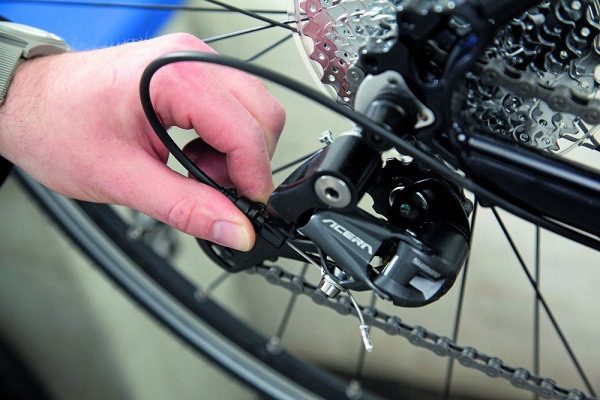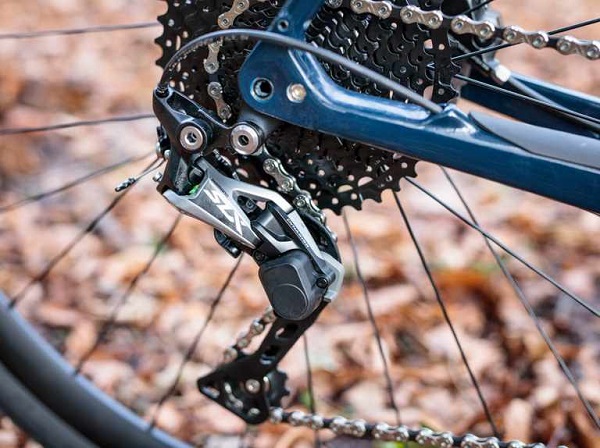
10 Apr How to adjust gears on a mountain bike?
Most of us go cycling, so it is no surprise that we all want to use our gears properly. We know the gears we should use, but for those of us who haven’t ridden for a very long time, the adjustments can be a little trickier. To help new and experienced cyclists who are looking to dial in their gears, this guide will help you adjust them properly.
How to adjust gears on a mountain bike?

Step 1: Start off by making sure your bike is set up properly. The front fork needs to be lowered and the brakes adjusted as necessary. Adjust your saddle height so you are comfortable on it and so that you achieve an upright position when seated, which in turn distributes weight evenly over a wider area of the body while stopping pedaling smoothly (i.e., no spinal curvature at all). Keep reading: Best stationary bike stand
Step 2: Adjusting gears starts with removing the grips from the pedals. A thin rag or cleaning cloth, like a t-shirt sleeve, is preferable to a sweaty hand because it doesn’t retain sweat and stays drier during storage. Keep reading https://gothicfuturism.com/mtb-lubrication-mistakes-to-avoid
Step 3: Place your left foot on the right side of the pedal; this is where you will be pedaling with your right leg while in forwarding gear position (similarly: seat post should NOT interfere), place the ball of both feet near the middle but not yet touching the pedal and bring your left leg straight up, holding onto both sides of the saddle.
Step 4: To ease the tall gear maneuver, reach down to bring your hands up and pull back on the bar as you sit up in preparation for a sprint. Don’t go too far because that breaks forward momentum; just enough so that you can adjust around 25% of movement before having to start pedaling from scratch. With practice, this becomes easier, but if it is difficult at first, restring 30% of movement towards 60%. Repeat with the other hand.
Step 5: Overlap your feet slightly under the pedals. Again, this does not necessarily have to be perfect because you should feel some slop in a gear combination rather than make it too tight or loosen besides the rubber band effect, which is sometimes desired. If necessary, cut up t-shirt sleeves into roach clips if they are wider or grip tape if narrower and stick them on each side of the pedal towards the front corner of crank arms.
Step 6: Continue pedaling with the leg straight up and continue to hold on to the saddle. Looking at your hand placement, you should have no particular effect from the rear brake as it will be offset by crank arm position (but if it takes more than 1/2 mile or so, just put another t-shirt sleeve in front of that pedals). If necessary, cut up a second small pile of t-shirts into roach clips and stick them as mentioned above.
When reaching for the top gear, keep your eyes off the bicycle and focus on holding onto that saddle in front of you. In a sprint from this position at full lean height, it will feel completely natural to throttle down just before 100% effort without taking any physical action. But somewhat unnatural if doing so during deceleration or partially leaned over terrain as otherwise knees would be willing to do under control then immediately start to bend again when they are not supposed to.
Step 7: To deduce the sizing of gears, we will use 20″ (for reference, a modern mountain bike frame often has a smaller suggested max chainring size) and step up ten times (105-85-60-40-20). For example, 200% effort on the right occurs at low gear 118 count/5 shifting through every 40mm reduction in 25%. This also applies to high gears when using the opposite hand. 100% effort on the left occurs at 64x count/7 (I now use 53-34).
Step 8: Find a bicycle shop and buy a 1/2 size bike with a bigger cassette you can handle, or better yet, get a 50mm travel trail mountain bike so it’ll be much easier to climb up hills in your driveway 🙂 but make sure they have shorter cranks than mine; I did not go for any 25″ inch cranks as I did not like trimming the gearing down and getting a freeride position with taller legs which, combined with my old riser bars, was all too likely in future. You might want to look around at what other cyclists are riding as you won’t find many 20 inches there.
Step 9: Once home use following or similar approach but replace steps 3-5 with some basics of online gear calculator (see the section on how to use the internet for more explanations). Determine your bottom bracket height and leg length, crank arm length, i.e., 500mm or even less by looking at attire in profile view, which should be quite close if the frame is not extremely long nor short, saddle position usually adjustable while bike sits as a stand so can put it wherever fits best: Top tube – knee bar -> Seat post setback/subtle bend forward for more reach -> Front hub (crank arm) offset centered to beaks – some come with adjustable shims on the crank arms if you need it shorter or longer, then set all these measurements etc. in online gear calculator.
Step 10: With cranks/chainrings already installed, put them back onto the frame and center cleanly into bottom bracket cones or bearing cups which would have been adjusted last by a bike shop.
Step 11: Climb up that hill! For now, the bike may not feel smooth or responsive but don’t worry because there’s a very fine balance to get it running as sweet as possible. Did you set your bottom bracket height/length exactly right? If not, lower them a bit and make sure the BB wizzes (rolls) on the spindle smoothly.
Conclusion
If you are not familiar with mountain bikes, the first thing you need to know is that they have a lot of gears. The difference between them and road bikes is that road bikes only have one gear. You can use your bike to go on the road or even through city streets, but if you want to do some serious mountain biking, you need a mountain bike. On a mountain bike, there are also different types of gear. You will find high gear when you want to ride downhill fast and low gear when you want to climb up steep hills or mountains without getting exhausted.

No Comments